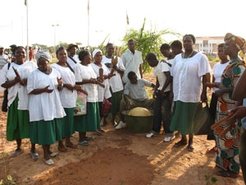Creole Identity, Interethnic Relations and Post-Colonial Nation-Building in Guinea-Bissau, West Africa
The research project seeks to explore the formation and transformation of creole identity in the context of intra-ethnic, inter-ethnic, and urban-rural relations in postcolonial times.
The littoral zones of present-day Guinea-Bissau have been a focal point of European, Cape Verdean, and African commercial interests since the 15th century when trading posts, so called praças, were established along the Upper Guinea Coast. A process of creolisation set in and new cultural and linguistic forms emerged, which subsequently became constitutive elements of a new collective identity among the praças’ residents who were known as Kristons (“Christians”).
The Portuguese colonialists introduced legal distinctions between “indigenous” subjects and “civilised” citizens (“Native Statute”) in the early 20th century. Henceforth, creoles were split up among these two legal categories. To this day, this legal classification has an important impact on creole self-conceptualization and lifestyle and those labelled as “civilised” remain a rather heterogeneous group, comprising of different groups besides the creoles.

Manjuandadi Association in Action
The abnegation of the “Native Statute” in 1961 effected a process of indigenisation of creole culture and identity.
The most important contribution to national identity and nation-building in Guinea-Bissau was made by Amílcar Cabral. Himself a creole, he developed an ideology of anticolonialism, national liberation, and national unity. Cabral was the first to succeed in uniting both creoles and the “indigenous” hinterland population in the war of independence that started in 1963. The numerical marginalisation of creoles in postcolonial society has led one part of the creole population to indigenize, another part to emphasise its distinctiveness and separation from the hinterland population.
As part of the indigenisation of creole culture and identity, creole institutions have been regionally, socially and ethnically opening up and expanding, thereby becoming increasingly transethnic. There are two institutions which best illustrate this process:
- Primarily female associations of mutual solidarity known as manjuandadis which were originally restricted to distinct age sets of creole society. After independence many manjuandadis served the one-party state as instruments of transmission. The politicisation of these institutions also effected their regional and social expansion.
- Carnival, which was celebrated in the praças, was restricted to creoles until the early 1970s. As a result of the mass mobilisation undertaken by the single political party’s youth organisation, carnival was organised as a national competition, thereby expanding beyond creole society and gradually becoming a national institution.
In Guinea-Bissau, creole identity has not been transformed into a distinct ethnic identity, as it has in other parts of the Upper Guinea Coast, e.g. Sierra Leone. Instead, it has acquired transethnic significance. One exception are the Kristons de Gêba, who were not classified as “civilised” by the colonial regime but nevertheless considered themselves as such. In contrast to other former praças, the Kristons de Gêba developed a creole identity distinctly ethnic in character. They originate from the former important trading post of Gêba which is situated in a predominantly Muslim region. The Kristons de Gêba constructed their manifest ethnic identity against this Muslim background. Currently, the Kristons de Gêba are attempting to re-establish colonial or “traditional” leadership structures, an indication of a process of reinforced ethnicisation.
After independence in 1974, the offspring of the previously privileged “civilised” citizens – many of them creoles – figured prominently among the country’s socio-cultural, political, and economic elite. However, the military conflict of 1998/99, which weakened state structures, and the continuing marginalisation of creoles in the commercial sector decreased their social status and led to increasing emigration, especially to Portugal and Cape Verde.
